Water Mains Rehabilitation (NI Water) (2016)
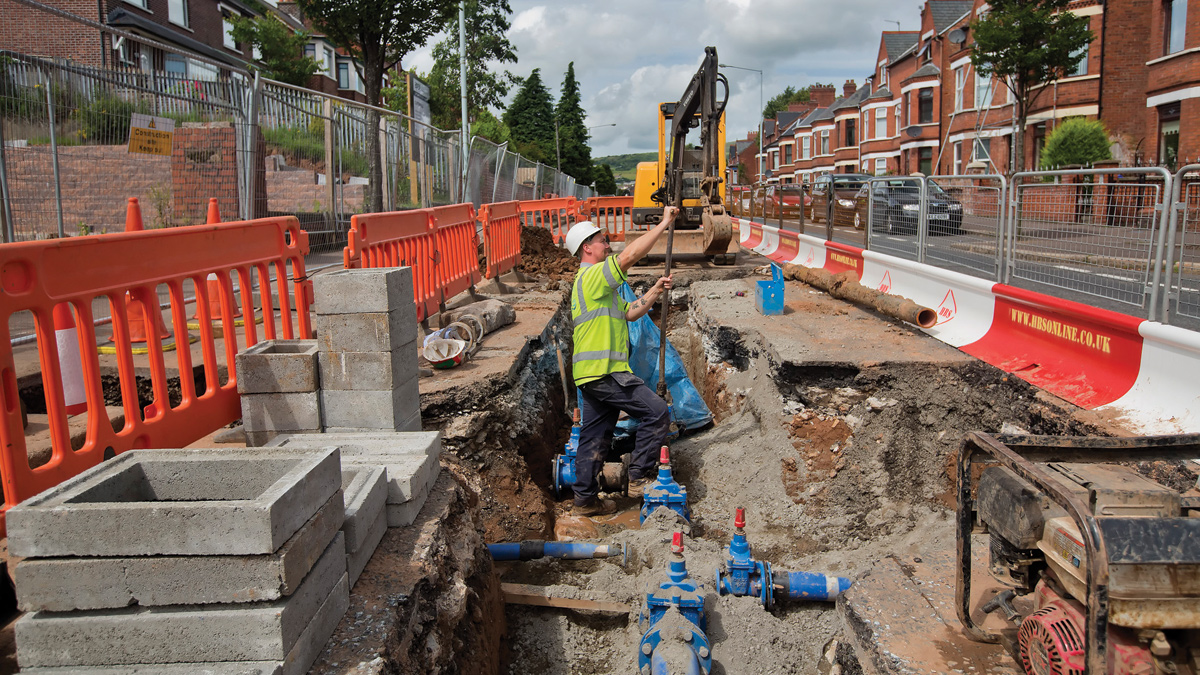
Water mains improvement work continues on the Cliftonville Road - Courtesy of NI Water
The existing water mains infrastructure in Northern Ireland consists of 26,500km of pipes supplying 625 million litres of water per day to 1.8 million consumers in households, farms and businesses. While consumers are served well by the existing infrastructure, many parts of the network are well over 40 years old. Lack of investment over the last 30 years has led to significant parts of the system becoming defective, leading to bursts, leaks, water quality issues and pressure problems. Large sections of the antiquated system are made up of unlined iron water mains, which are in need of replacement.
Background
In 2010, Northern Ireland Water (NI Water) embarked on its Water Mains Rehabilitation Programme, an extensive 5 year project aimed at upgrading a range of water mains across both rural and urban areas of Northern Ireland. The main objective of the programme was to improve the performance of the water mains and provide a more reliable and secure water supply system.
The Water Mains Rehabilitation Programme
The two year price control period of PC13 from April 2013 to March 2015 required NI Water to deliver 445km of water mains consisting of various diameters at a project budget of £50.3m. This PC13 programme represented part of an estimated £165m investment over the next eight year period to 2021 aimed at improving the water distribution system.
The PC13 outcome demonstrated that the project outperformed on its targets by completing over 447km for £48m. This represented a unit rate of approximately £108/m against a target of £113/m.
The project comprised of a series of individual schemes, which will collectively provide a more reliable and secure water supply system in Northern Ireland that meets the increasingly stringent standards set by the European Union.
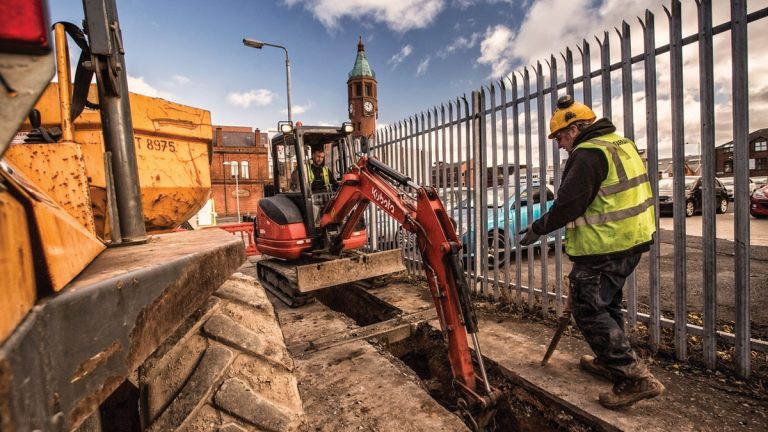
Water mains improvement work continues in the Belfast area (spring 2016) – Courtesy of NI Water
Needs and options stage
The nature and severity of any problems with the water mains in a rehabilitation zone were identified during detailed zonal studies (DZS). The DZS facilitates the assessment of the performance of the water network against a set of ‘Key Performance Indicators’ and comprised of two main components, the Needs Report and the Options Report.
- The Needs Report summarises the results of the assessment of the existing network in terms of structural condition, hydraulic performance, water quality and operational performance.
- The Options Report identifies the construction work that should be undertaken to address the problems identified in the Needs Report.
The enabling stage
The enabling stage involves one of the framework contractors completing site investigatory works on an allocated work package to identify the risks associated with each water main scheme. A number of these risks include constraints due to ground conditions, existing utility services and traffic management issues.
The site investigation works allow optimisation on the best construction technique for the installation of the water main, in order to achieve the best value for money. On completion of the investigatory works, a decision panel confirms the installation techniques in agreement with the project management team and the operational staff from NI Water. On agreement, the contractor will then confirm the project budget for approval by the NI Water project team to progress forward to the construction stage.
The construction stage
The NEC 3 Option B contract is undertaken by a consortium of Northern Ireland based contractors who have the extensive design, civil engineering and mechanical and electrical experience along with invaluable local supply links and geographical knowledge required to successfully execute the scheme.
The two appointed contractors are Lagan Construction and Farrans Construction, and the delivery mechanism is based on design and build with both contractors having nominated designers to support the programme of works. The contractors work alongside a dedicated project management team comprising specialists from Atkins Consultants and NI Water, who manage the successful delivery of the project across Northern Ireland.
The project also has dedicated NI Water operational staff from the Customer Service Delivery Directorate who assist in managing the interface between the construction works and continual supply of water to the customers. The NI Water staff also work closely with the contractors to ensure the proposed construction methodologies are appropriate for the short and long term needs of the water supply network.
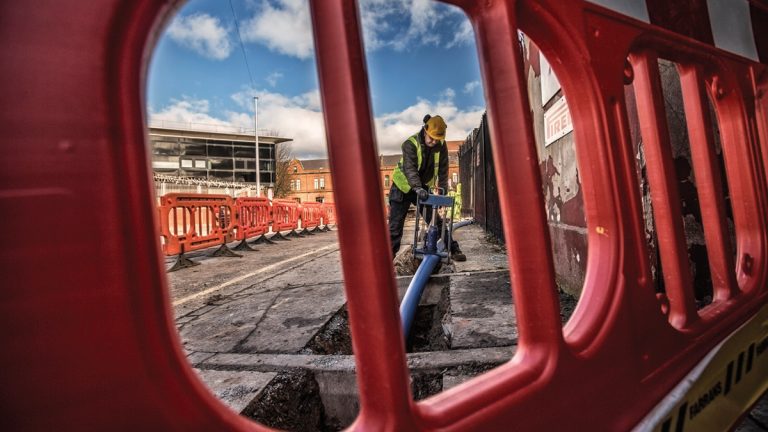
Water mains improvement work continues in the Belfast area (spring 2016) – Courtesy of NI Water
The rehabilitation programme ensures a large emphasis is placed on providing high levels of customer care, which includes the minimisation of supply disruptions and general disruption during the works. A customer care specification has been developed especially for these works and each contractor has a dedicated Customer Care Manager due to the large number of pipe laying squads on the ground.
Customer letter drops with specific project leaflets are circulated within the vicinity of each new works area to ensure that all residents within the area are aware of when and why the work is taking place. In addition, the project team ensures early stakeholder involvement on a regular basis with politicians, local councils, businesses, community groups and statutory authorities including Roads Service and other utility companies.
The project team developed a bespoke cost management system (CMS) to provide accurate data for analysing costs on each water main scheme to ensure value for money is achieved by NI Water.
CMS is used on a daily basis by both the contractors and NI Water to upload and approve all site measurements for payment purposes.
This data is also used to provide accurate reports on outputs with the Northern Ireland Authority for Utility Regulation.
Case Study: Newtownabbey Trunk Mains
As part of the Water Mains Rehabilitation Programme, the Newtownabbey Trunk Mains Project represented a £2m investment to improve water quality to the greater Belfast area by the replacement of approximately 2km of 24” diameter and 18” diameter twin trunk mains from Whiteabbey Lower Service Reservoir to Monkstown Well. The existing mains were laid in the 1950s to replace a conduit which had supplied water to the greater Belfast area.
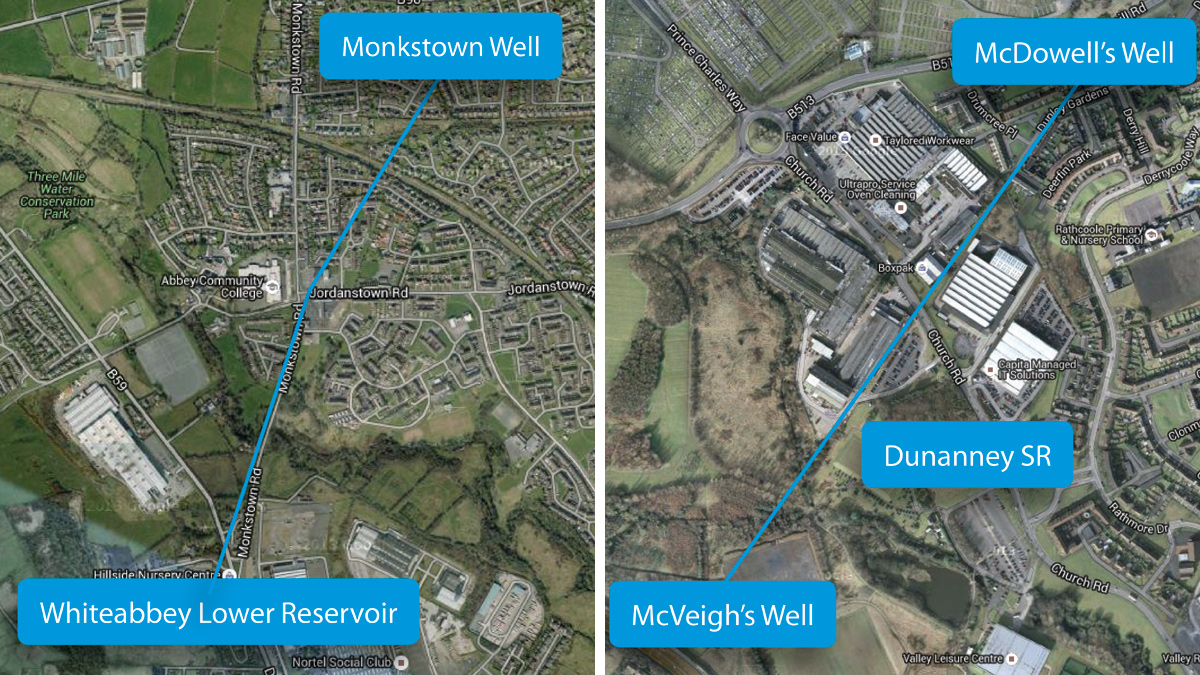
Newtownabbey Trunks Main plan of route – Courtesy of NI Water
The trunk mains were supplying a number of service reservoirs within the Belfast area and it was essential that flows were maintained by keeping one trunk main in operation at all times. The route included sections of trunk mains through residential areas, live and disused railway lines, industrial sites and a busy arterial route into Belfast City Centre.
The Monkstown Road is one of the busiest arterial roads into Belfast and required consultation between NI Water and the key stakeholders including Transport NI and NIR at an early stage. The programme of consultation with the local community, businesses and schools was completed well in advance of the work, including a presentation to Belfast City Councillors and regular meetings with all MLA’s, local representatives and the local chamber of commerce. The consultation process was also supported by regular customer letter drops and press releases to the local media and traffic bulletins on the radio.
The method and design for the replacement of the trunk mains included slip-lining of the 24” cast iron main with a 560mm diameter PE main and the slip-lining of the 18” cast iron main with a 400mm diameter PE main. The slip-lining process was relatively straightforward using a combination of pipebursting rods or drill rods and once installed in the parent pipe and the new PE main attached at one end, it was simply a question of pulling the rods back towards the machine and removing rods as the installation process continued.
One valuable lesson learned was the importance of extensive surveys on the mains to be slip-lined to confirm records and in planning and sequencing of the works.
The Newtownabbey Trunk Mains project was successfully completed on schedule and on budget with exception of a 30m section of mains across the live railway line. This work will be completed later this year in liaison with Northern Ireland Railways. Work was also completed with minimal disruption to road users and local residents in the area.
Progress to date
The 2 year PC13 programme has invested over £48m up to the end March 2015 and delivered over 447km of water mains across Northern Ireland, exceeding the original target of 445km agreed with the Regulator.
The installation techniques include open cut, directional drilling, pipe-bursting, slip-lining and semi-structural lining. The trenchless technologies utilised account for 75% of the water mains replaced or rehabilitated.
The six year PC15 delivery programme to March 2021 will continue to invest a further £114m and deliver an estimated 905km of water mains. The first year of PC15 is complete and NI Water is out-performing the targets set out by the Utility Regular for this period.
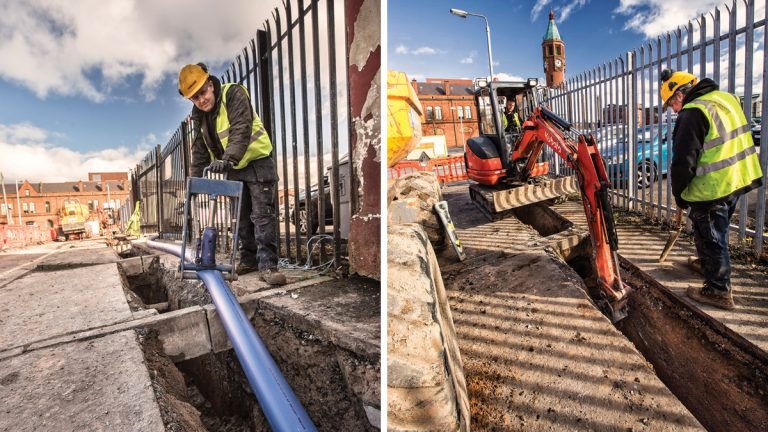
Water mains improvement work continues in the Belfast area (spring 2016) – Courtesy of NI Water
Conclusions
The Water Mains Rehabilitation Programme will bring many benefits, including increased compliance with the Water Quality (Water Supply) Regulations Northern Ireland, increased operational reliability and flexibility, a reduction in the number of interruptions to customer supplies due to emergency repairs to burst water mains, reduced leakage levels and it will facilitate social and economic development across Northern Ireland.




